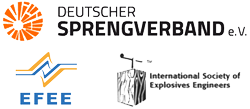First Continuous use over 3 Months of the “Ontaris Explosives Stock Book
Since mid-June 2014, the company “Zement- und Kalkwerke Otterbein GmbH & Co. KG” is in the practical testing phase of the Ontaris Explosives Stock Book. In close cooperation with MAXAM, Otterbein is the first company in Germany that has adopted Track and Trace with electronic stock accounting in its regular operations.
The Otterbein cement and lime works are located between the Vogelsberg and Rhön mountains. The company was founded about 125 years ago in the Lauterbacher Graben, as a merger of several small lime kilns.

Wanted: Simple and Clear Solution
Today, Otterbein mines almost 500,000 tons of limestone annually. To enable this production, blasting is carried out every 2-3 days. Thus, the new EU directive for the labeling and tracing of explosives also applies to Otterbein Cement and Lime Works.
For this reason, Mr. Pfohl, head of quarry operations and blasting manager, dealt very early with the new requirements that will come into force in April 2015. Since the fall of 2013, he had been looking for a suitable solution to meet these new requirements.
In addition to compliance with the EU labeling directive, it should be ensured that no Internet connection is required for operation, as the warehouse does not have a corresponding installation. The equipment used must comply with the recommendations of BAM, which ensure that it can be used safely in the explosives store. In addition, the solution must be accepted by local authorities as a replacement for the previous stock ledger. In addition, there should be no ongoing costs and it should also be possible to change suppliers without any problems if necessary.
It was also important that no major changes had to be made to the existing workflow, but that the new solution should integrate well with the existing processes. Otterbein also wanted to use this labeling requirement to switch from the paper explosives stock ledger to an electronic solution.
With the Explosives Stock Book from Ontaris, consisting of a 9″ tablet PC with a handy Bluetooth scanner, he found a corresponding standard solution on the market that met his requirements.
First Pilot Operation Nationwide
At the end of June 2014, the Ontaris Explosives Stockpile Book was used for the first time in the Otterbein quarry. The quarry receives a shipment of explosives about every 3 weeks, averaging 4-5 pallets each. Since that time, the electronic explosives stock ledger has been used throughout.
The Day 1
The Electronic Stock Book, consisting of the tablet PC and the Bluetooth hand scanner, was already configured by Ontaris in advance, so that with the first explosives delivery by the company MAXAM, the recording of the goods could be started directly.
At 7 a.m. on the dot, the explosives order was delivered to the explosives warehouse. Immediately upon arrival, Mr. Pfohl checked the delivery with the paper delivery bill, as he had done in the past.
For the traceability of the explosives and to enable electronic stock accounting, the driver brings a supplier file in XML format. This contains the list of all identification numbers of items and packages in the delivery. For simplicity, this file was brought on a USB stick. The file is imported by the software and the USB stick is returned directly to the supplier.
To ensure that the box numbers or item numbers in the supplier XML file match the actual delivery, Mr. Pfohl now performs a random check with the scanner. To do this, he scans all the boxes to make sure they are all correctly included in the supplier file. With these boxes, he sees a very low probability that the contents will not match, since they have not been modified after production. With the pre-assembled detonator bundles, the probability of error is higher due to manual packaging. For this reason, he opens the packages and checks the items they contain one by one. Here, Bernhard Pfohl is particularly pleased with the small handheld scanner: “I can now use it to scan boxes that are close to the wall.” After the successful sampling, Mr. Pfohl enters the goods into the stock ledger.
Incoming Goods in only 5 min
“This detailed goods receipt takes barely 5 minutes and now I no longer have to keep a Stock Book on paper or rework something on the PC in the evening. That saves a lot of time,” says Bernhard Pfohl. When the goods receipt is posted on the tablet PC, the Stock Book is also written immediately. “Now, when our supervising superintendent comes to me at the quarry, I can immediately show him the stockpile without any additional effort.”
Now that he has brought the goods to his warehouse, he selects and scans the explosives for the next blast. Then he loads them onto his truck and drives to the blast site.
If he did not consume some items during blasting, he brings them back after the blasting is completed and performs feedback. To do this, he simply scans the items again and thus posts them back to the Stock Book.
“The redemption of cord is made really easy here. I scan the reel and then a field appears on the screen. I then write in how much I have used and it then calculates for itself how much cord is still on it. Very simple!” praises Mr. Pfohl.
He also likes the ease of adding items with unreadable labels back into inventory. Due to contamination on the blasting area, it can quickly happen that a label is completely destroyed and the barcode can no longer be read. “Even though I haven’t needed to do this yet this summer, it happens more often than you think, especially when the weather gets worse now.”
Conclusion
After these 3 months of intensive use of the Ontaris Explosives Stock Book, Mr. Pfohl is convinced: “The software is easy to use, very clear and works reliably. It does exactly what it is supposed to do. It is also good that we can already gain experience with the system now and Ontaris can take this into account in further development.”





